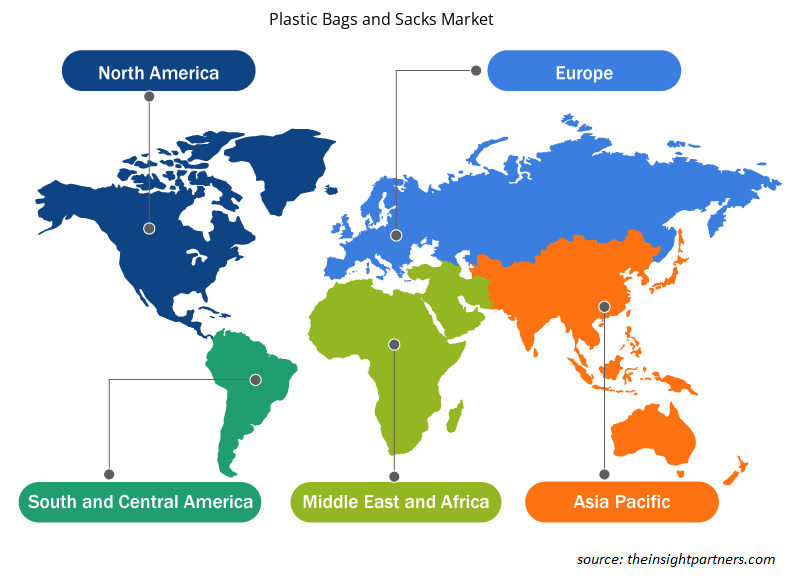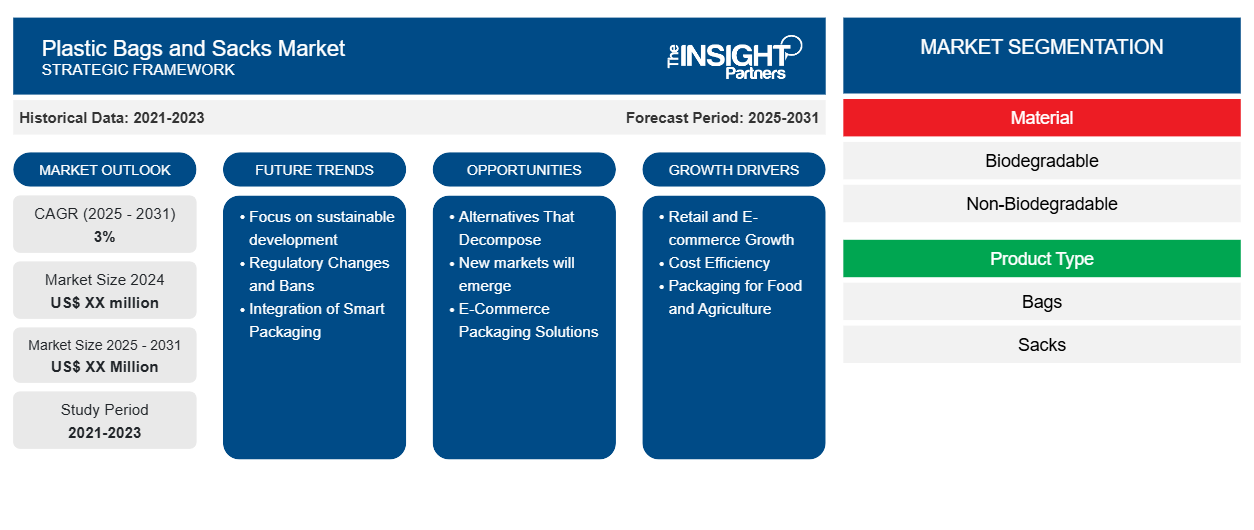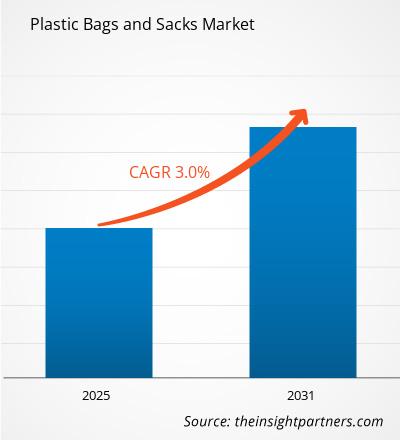Si prevede che il mercato dei sacchetti e dei sacchi di plastica registrerà un CAGR del 3% dal 2023 al 2031, con una dimensione di mercato in espansione da XX milioni di dollari nel 2023 a XX milioni di dollari entro il 2031.
Il mercato dei sacchetti e delle buste di plastica comprende l'analisi per materiale (biodegradabile, non biodegradabile); tipo di prodotto (sacchetti, sacchi) e area geografica (Nord America, Europa, Asia Pacifico, Medio Oriente e Africa e Sud e Centro America). I sacchetti e le buste di plastica sono talvolta noti come polybag e sono realizzati interamente in sottile pellicola di plastica. I sacchetti e le buste di plastica sono spesso utilizzati nel settore dei beni di consumo per confezionare alimenti confezionati, vestiti, frutta fresca, cancelleria e altri articoli. I sacchetti sono relativamente traslucidi, flessibili e resistenti allo strappo. Inoltre, hanno eccezionali qualità di barriera all'umidità. I sacchetti e le buste di plastica sono utilizzati in una varietà di settori, tra cui vendita al dettaglio, alimenti e bevande, servizi istituzionali e altri.
Scopo del rapporto
Il report Plastic Bags and Sacks Market di The Insight Partners mira a descrivere il panorama attuale e la crescita futura, i principali fattori trainanti, le sfide e le opportunità. Ciò fornirà spunti a vari stakeholder aziendali, come:
- Fornitori/produttori di tecnologia: per comprendere le dinamiche di mercato in evoluzione e conoscere le potenziali opportunità di crescita, consentendo loro di prendere decisioni strategiche informate.
- Investitori: condurre un'analisi completa delle tendenze in merito al tasso di crescita del mercato, alle proiezioni finanziarie del mercato e alle opportunità esistenti lungo la catena del valore.
- Enti di regolamentazione: regolamentano le politiche e le attività di controllo sul mercato allo scopo di ridurre al minimo gli abusi, preservare la fiducia degli investitori e sostenere l'integrità e la stabilità del mercato.
Segmentazione del mercato dei sacchetti e dei sacchi di plastica
Materiale
- Biodegradabile
- Non biodegradabile
Tipo di prodotto
- Borse
- Sacchi
Personalizza questo report in base alle tue esigenze
Riceverai la personalizzazione gratuita di qualsiasi report, comprese parti di questo report, o analisi a livello nazionale, pacchetto dati Excel, oltre a usufruire di grandi offerte e sconti per start-up e università
- Scopri le principali tendenze di mercato in questo rapporto.Questo campione GRATUITO includerà analisi di dati che spaziano dalle tendenze di mercato alle stime e alle previsioni.
Fattori trainanti della crescita del mercato dei sacchetti e dei sacchi di plastica
- Crescita del commercio al dettaglio e dell'e-commerce: il boom del commercio al dettaglio e dell'e-commerce, in particolare degli acquisti online, sta creando un'enorme domanda di sacchetti e buste di plastica, tra le altre soluzioni di imballaggio, fondamentali per consegnare i prodotti in modo sicuro, economico ed efficiente, poiché i sacchetti di plastica leggeri e resistenti sono essenziali per la logistica degli ordini online, stimolando ulteriormente la crescita del settore dell'imballaggio.
- Efficienza dei costi: non esiste un modo alternativo per sostituire i costosi metodi di utilizzo di carta o tessuto per fabbricare una borsa o un sacco. La tecnologia relativamente più bassa impiegata nella produzione, il trasporto di pesi o carichi pesanti con una maggiore capacità di carico e la produzione di massa continua l'hanno attratta per vari tipi di settori che vanno dalla vendita al dettaglio stessa all'alimentazione e all'agricoltura; quindi, contribuiscono anche alla crescita complessiva del mercato.
- Imballaggi per alimenti e agricoltura: tra i due settori confezionati con requisiti di fascia alta, agricoltura e alimenti hanno il numero più elevato di sacchi e sacchetti di plastica utilizzati per scopi di imballaggio e trasporto. Questi tre parametri definiscono la plastica: resistenza, resistenza all'umidità e protezione; quindi, la quantità massima è conservata sotto i cereali, i prodotti e tutti i prodotti deperibili; quindi la domanda dal mercato continuerà, specialmente dalle nazioni africane che sviluppano le loro aree agricole.
Tendenze future del mercato dei sacchetti e dei sacchi di plastica
- Concentrarsi sullo sviluppo sostenibile: la crescente consapevolezza ambientale fa emergere l'importanza di avere buste di plastica che salvaguardino l'ambiente. Le buste di plastica biodegradabili, riciclabili o compostabili emergono come alternative alla plastica tradizionale. I produttori inventeranno quindi materiali fabbricati in modo ecologico per soddisfare le normative e aiutare i consumatori a consumare meno, in modo da tenere il passo con la tendenza per imballaggi più ecologici.
- Cambiamenti normativi e divieti: la maggior parte dei paesi sta diventando più severa nell'applicazione delle leggi relative alla plastica monouso. Infatti, alcuni di loro hanno vietato del tutto determinati tipi di plastica. Pertanto, in questa tendenza, le aziende dovranno trovare alternative come carta, plastica riutilizzabile e sacchetti di origine vegetale. Con questo, ci saranno più innovazioni nelle alternative ecologiche che cambieranno davvero il panorama dei sacchetti e delle buste di plastica.
- Integrazione di Smart Packaging: le future buste di plastica implicheranno tecnologie intelligenti. Queste includono imballaggi intelligenti come buste con tag RFID incorporati per il tracciamento o funzionalità sensibili alla temperatura, che forniranno maggiore praticità ai consumatori e una migliore offerta nella gestione della supply chain per un vantaggio nella concorrenza per settori come quello alimentare e farmaceutico.
Opportunità di mercato per sacchetti e sacchi di plastica
- Alternative che si decompongono: si prevede che le buste di plastica biodegradabili o compostabili rappresentino opportunità di sviluppo per i produttori a causa del clamore mondiale per la riduzione dei rifiuti di plastica. I produttori già eco-compatibili trarrebbero vantaggio dal fatto che i consumatori diventerebbero più eco-sensibili, acquistando buste ecocompatibili realizzate con materiali di origine vegetale o compostabili.
- Emergeranno nuovi mercati: l'ondata di mercati emergenti in Asia-Pacifico, Africa e America Latina è un'opportunità molto brillante nel mercato dei sacchetti e delle buste di plastica a causa della rapida urbanizzazione e industrializzazione. Un reddito più alto, una domanda crescente di prodotti confezionati, specialmente nei settori della vendita al dettaglio e alimentare, porta a più consumatori inutilizzati.
- Soluzioni di imballaggio per l'e-commerce: l'espansione del settore dell'e-commerce crea un'ottima opportunità per soluzioni di imballaggio dedicate allo shopping online. Sacchetti e buste di plastica progettati per una consegna sicura, leggeri e convenienti durante la produzione di tali sacchetti saranno richiesti e quindi forniranno ai produttori la possibilità di ideare imballaggi specializzati per la vendita al dettaglio online.
Approfondimenti regionali sul mercato dei sacchetti e dei sacchi di plastica
Le tendenze regionali e i fattori che influenzano il mercato dei sacchetti e dei sacchi di plastica durante il periodo di previsione sono stati ampiamente spiegati dagli analisti di Insight Partners. Questa sezione discute anche i segmenti e la geografia del mercato dei sacchetti e dei sacchi di plastica in Nord America, Europa, Asia Pacifico, Medio Oriente e Africa e Sud e Centro America.

- Ottieni i dati specifici regionali per il mercato dei sacchetti e dei sacchi di plastica
Ambito del rapporto di mercato sui sacchetti e sacchi di plastica
| Attributo del report | Dettagli |
|---|---|
| Dimensioni del mercato nel 2023 | XX milioni di dollari USA |
| Dimensioni del mercato entro il 2031 | XX milioni di dollari USA |
| CAGR globale (2023-2031) | 3% |
| Dati storici | 2021-2022 |
| Periodo di previsione | 2024-2031 |
| Segmenti coperti | Per materiale
|
| Regioni e Paesi coperti | America del Nord
|
| Leader di mercato e profili aziendali chiave |
|
Densità degli operatori del mercato dei sacchetti e dei sacchi di plastica: comprendere il suo impatto sulle dinamiche aziendali
Il mercato dei sacchetti e dei sacchetti di plastica sta crescendo rapidamente, spinto dalla crescente domanda degli utenti finali dovuta a fattori quali l'evoluzione delle preferenze dei consumatori, i progressi tecnologici e una maggiore consapevolezza dei benefici del prodotto. Con l'aumento della domanda, le aziende stanno ampliando le loro offerte, innovando per soddisfare le esigenze dei consumatori e capitalizzando sulle tendenze emergenti, il che alimenta ulteriormente la crescita del mercato.
La densità degli operatori di mercato si riferisce alla distribuzione di aziende o società che operano in un particolare mercato o settore. Indica quanti concorrenti (operatori di mercato) sono presenti in un dato spazio di mercato in relazione alle sue dimensioni o al valore di mercato totale.
Le principali aziende che operano nel mercato dei sacchetti e delle buste di plastica sono:
- Azienda
- Azienda
- Società per azioni Novolex Holdings, Inc.
- Gruppo Mondi
- Società per azioni Ampac, LLC
Disclaimer : le aziende elencate sopra non sono classificate secondo un ordine particolare.

- Ottieni una panoramica dei principali attori del mercato dei sacchetti e sacchi di plastica
Punti chiave di vendita
- Copertura completa: il rapporto esamina in modo completo i prodotti, i servizi, le tipologie e gli utenti finali del mercato dei sacchetti e dei sacchi di plastica, offrendo una panoramica olistica.
- Analisi degli esperti: il rapporto è compilato sulla base della conoscenza approfondita di esperti e analisti del settore.
- Informazioni aggiornate: il rapporto garantisce la pertinenza aziendale grazie alla copertura di informazioni recenti e tendenze nei dati.
- Opzioni di personalizzazione: questo report può essere personalizzato per soddisfare le esigenze specifiche del cliente e adattarsi in modo appropriato alle strategie aziendali.
Il rapporto di ricerca sul mercato dei sacchetti e delle buste di plastica può, quindi, aiutare a guidare il percorso di decodificazione e comprensione dello scenario del settore e delle prospettive di crescita. Sebbene possano esserci alcune preoccupazioni valide, i vantaggi complessivi di questo rapporto tendono a superare gli svantaggi.
- Analisi storica (2 anni), anno base, previsione (7 anni) con CAGR
- Analisi PEST e SWOT
- Valore/volume delle dimensioni del mercato - Globale, regionale, nazionale
- Industria e panorama competitivo
- Set di dati Excel


- Pharmacovigilance and Drug Safety Software Market
- Electronic Toll Collection System Market
- Medical Devices Market
- Explosion-Proof Equipment Market
- Portable Power Station Market
- Embolization Devices Market
- Military Rubber Tracks Market
- Adaptive Traffic Control System Market
- Radiopharmaceuticals Market
- Parking Management Market

Report Coverage
Revenue forecast, Company Analysis, Industry landscape, Growth factors, and Trends

Segment Covered
This text is related
to segments covered.

Regional Scope
North America, Europe, Asia Pacific, Middle East & Africa, South & Central America

Country Scope
This text is related
to country scope.
Domande frequenti
The North America market is expected to account for the highest CAGR during the forecast period owing to the growing packaging industry in the region.
The bag product type segment accounted for the largest market share in 2023
Rutan Poly Industries, Inc., Berry Plastics Inc., Novolex Holdings, Inc., Mondi Group, Ampac Holdings, LLC, International Plastics Inc., Bischof and Klein GmbH and Co., Interplast Group, Starlinger and Co., and Hanoi Plastic Bag JSC are some of the key players in the market.
Growing packaging industry is a key driver in the market
The Plastic Bags and Sacks Market is estimated to witness a CAGR of 3% from 2023 to 2031
Growing adopption of reusable bags is an emerging trend in the market.
Trends and growth analysis reports related to Chemicals and Materials : READ MORE..
- Rutan Poly Industries, Inc.
- Berry Plastics Inc.
- Novolex Holdings, Inc.
- Mondi Group
- Ampac Holdings, LLC
- International Plastics Inc.
- Bischof and Klein GmbH and Co.
- Interplast Group
- Starlinger and Co.
- Hanoi Plastic Bag JSC
The Insight Partners performs research in 4 major stages: Data Collection & Secondary Research, Primary Research, Data Analysis and Data Triangulation & Final Review.
- Data Collection and Secondary Research:
As a market research and consulting firm operating from a decade, we have published and advised several client across the globe. First step for any study will start with an assessment of currently available data and insights from existing reports. Further, historical and current market information is collected from Investor Presentations, Annual Reports, SEC Filings, etc., and other information related to company’s performance and market positioning are gathered from Paid Databases (Factiva, Hoovers, and Reuters) and various other publications available in public domain.
Several associations trade associates, technical forums, institutes, societies and organization are accessed to gain technical as well as market related insights through their publications such as research papers, blogs and press releases related to the studies are referred to get cues about the market. Further, white papers, journals, magazines, and other news articles published in last 3 years are scrutinized and analyzed to understand the current market trends.
- Primary Research:
The primarily interview analysis comprise of data obtained from industry participants interview and answers to survey questions gathered by in-house primary team.
For primary research, interviews are conducted with industry experts/CEOs/Marketing Managers/VPs/Subject Matter Experts from both demand and supply side to get a 360-degree view of the market. The primary team conducts several interviews based on the complexity of the markets to understand the various market trends and dynamics which makes research more credible and precise.
A typical research interview fulfils the following functions:
- Provides first-hand information on the market size, market trends, growth trends, competitive landscape, and outlook
- Validates and strengthens in-house secondary research findings
- Develops the analysis team’s expertise and market understanding
Primary research involves email interactions and telephone interviews for each market, category, segment, and sub-segment across geographies. The participants who typically take part in such a process include, but are not limited to:
- Industry participants: VPs, business development managers, market intelligence managers and national sales managers
- Outside experts: Valuation experts, research analysts and key opinion leaders specializing in the electronics and semiconductor industry.
Below is the breakup of our primary respondents by company, designation, and region:

Once we receive the confirmation from primary research sources or primary respondents, we finalize the base year market estimation and forecast the data as per the macroeconomic and microeconomic factors assessed during data collection.
- Data Analysis:
Once data is validated through both secondary as well as primary respondents, we finalize the market estimations by hypothesis formulation and factor analysis at regional and country level.
- Macro-Economic Factor Analysis:
We analyse macroeconomic indicators such the gross domestic product (GDP), increase in the demand for goods and services across industries, technological advancement, regional economic growth, governmental policies, the influence of COVID-19, PEST analysis, and other aspects. This analysis aids in setting benchmarks for various nations/regions and approximating market splits. Additionally, the general trend of the aforementioned components aid in determining the market's development possibilities.
- Country Level Data:
Various factors that are especially aligned to the country are taken into account to determine the market size for a certain area and country, including the presence of vendors, such as headquarters and offices, the country's GDP, demand patterns, and industry growth. To comprehend the market dynamics for the nation, a number of growth variables, inhibitors, application areas, and current market trends are researched. The aforementioned elements aid in determining the country's overall market's growth potential.
- Company Profile:
The “Table of Contents” is formulated by listing and analyzing more than 25 - 30 companies operating in the market ecosystem across geographies. However, we profile only 10 companies as a standard practice in our syndicate reports. These 10 companies comprise leading, emerging, and regional players. Nonetheless, our analysis is not restricted to the 10 listed companies, we also analyze other companies present in the market to develop a holistic view and understand the prevailing trends. The “Company Profiles” section in the report covers key facts, business description, products & services, financial information, SWOT analysis, and key developments. The financial information presented is extracted from the annual reports and official documents of the publicly listed companies. Upon collecting the information for the sections of respective companies, we verify them via various primary sources and then compile the data in respective company profiles. The company level information helps us in deriving the base number as well as in forecasting the market size.
- Developing Base Number:
Aggregation of sales statistics (2020-2022) and macro-economic factor, and other secondary and primary research insights are utilized to arrive at base number and related market shares for 2022. The data gaps are identified in this step and relevant market data is analyzed, collected from paid primary interviews or databases. On finalizing the base year market size, forecasts are developed on the basis of macro-economic, industry and market growth factors and company level analysis.
- Data Triangulation and Final Review:
The market findings and base year market size calculations are validated from supply as well as demand side. Demand side validations are based on macro-economic factor analysis and benchmarks for respective regions and countries. In case of supply side validations, revenues of major companies are estimated (in case not available) based on industry benchmark, approximate number of employees, product portfolio, and primary interviews revenues are gathered. Further revenue from target product/service segment is assessed to avoid overshooting of market statistics. In case of heavy deviations between supply and demand side values, all thes steps are repeated to achieve synchronization.
We follow an iterative model, wherein we share our research findings with Subject Matter Experts (SME’s) and Key Opinion Leaders (KOLs) until consensus view of the market is not formulated – this model negates any drastic deviation in the opinions of experts. Only validated and universally acceptable research findings are quoted in our reports.
We have important check points that we use to validate our research findings – which we call – data triangulation, where we validate the information, we generate from secondary sources with primary interviews and then we re-validate with our internal data bases and Subject matter experts. This comprehensive model enables us to deliver high quality, reliable data in shortest possible time.


 Ottieni un campione gratuito per questo repot
Ottieni un campione gratuito per questo repot